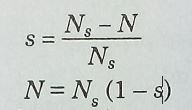Electrical Engineering ⇒ Topic : Slip
|
|
| William
| |
SLIP:- As earlier stated, the rotor speed must always remain less than the synchronous speed.The difference between the synchronous speed and the rotor speed is known as 'slip'.It is usually expressed as a fraction of the synchronous speed. Thus slip s is where Ns = synchronous speed (r.p.m.) N = motor speed (r.p.m.) In practice the value of slip is very small. At no-load, slip is around 1% or so and at full load it is around 3%. For large efficient machines the slip at full-load may be around 1% only.The induction motor, is therefore, a motor with substantially constant speed and fills the same role as D.C. shunt motor. When the rotor is stationary (standstill) its speed is zero and s = 1. The rotor cannot run at synchronous speed because then there will be no rotor e.m.f. and no rotor current and torque. If the rotor is to run at synchronous speed an external torque is necessary. If the rotor is driven such that N> Ns, the slip becomes negative, the rotor torque opposes the external driving torque and the machine acts as induction generator. The induction motor derives its name from the fact that the current in the rotor circuit is induced from the stator. There is no external connection to the rotor except for some special purposes If the rotor reactance at standstill is X2 it S value at slip 's' becomes sX2. This is very desirable. For at no-load the reactance becomes almost negligible and the rotor impedance is now all resistance. Further if the rotor resistance is small the rotor current is large, so that motor works with a large torque which brings the speed near to synchronous speed, i.e., the slip is reduced. | |
|
| |
!! OOPS Login [Click here] is required for more results / answer

 ................... (1)
................... (1)